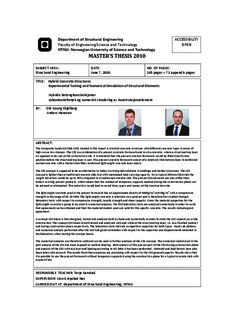| dc.contributor.author | Skjølberg, Ole Georg | nb_NO |
| dc.contributor.author | Hansson, Anders | nb_NO |
| dc.date.accessioned | 2014-12-19T11:59:00Z | |
| dc.date.available | 2014-12-19T11:59:00Z | |
| dc.date.created | 2011-04-11 | nb_NO |
| dc.date.issued | 2010 | nb_NO |
| dc.identifier | 409831 | nb_NO |
| dc.identifier.uri | http://hdl.handle.net/11250/236676 | |
| dc.description.abstract | The Composite Sandwich Slab (CSS) studied in this report is a hybrid concrete structure with different concrete types in zones of high versus low stresses. The CSS is a combination of a precast concrete formwork and in-situ concrete, where a structural top layer is supposed to be cast at the construction site. It is intended that the precast concrete formwork would be lifted directly into position before the structural top layer is cast. The precast concrete formwork consist of a relatively thin bottom layer in reinforced normal concrete with a thicker steel fiber reinforced lightweight concrete layer above.
The CSS concept is supposed to be an alternative to today’s existing slab solutions in buildings and harbor structures. The CSS concept is lighter than a traditional concrete slab, but with maintained load carrying capacity. For a typical 250mm thick slab the weight reduction would be up to 35% compared to a traditional concrete slab. The precast CSS elements are also stiffer than today’s existing precast products, which means that the number of temporary supports needed during the construction phase can be reduced or eliminated. This reduction would lead to saved time, space and money at the construction site.
The lightweight concrete used in the precast formwork has an approximate density of 900kg/m2 – 1150kg/m2 with a compressive strength in the range of 15-20 MPa. The lightweight concrete is relatively new product and is therefore first studied through laboratory tests with respect to compressive strength, tensile strength and shear capacity. Since the material properties for the lightweight concrete is going to be used in numerical analyses, the first laboratory tests are analyzed numerically in order to verify that agreement can be obtained and that the material models used are valid for this specific concrete. The results indicate good agreement.
A concept CSS beam is then designed, tested and analyzed both by hand and numerically in order to state the CSS capacity as a slab construction. The concept CSS beam is both tested and analyzed with and without the structural top layer, i.e. as a finished product and during construction phase respectively. The laboratory tests indicate competitive capacities for both types. Hand calculations and numerical analysis performed after the test had good correlation with respect to the capacities and displacements obtained in the laboratory when testing the concept beam.
The numerical analyses are therefore valid and can be used in further analyses of the CSS concept. The numerical model used in the post analysis of the CSS has been exposed to realistic loading. Both analysis of the precast part of the CSS during construction phase and analysis of the CSS with top layer and loading according to NS 3491-1 has been performed. Material and load factors have also been taken into account. The results from these analyses are promising with respect to the CSS general capacity. Results show that it is possible to use the precast formwork without temporary supports during the construction phase for a typical concrete slab with a span of 6m. | nb_NO |
| dc.language | eng | nb_NO |
| dc.publisher | Norges teknisk-naturvitenskapelige universitet, Fakultet for ingeniørvitenskap og teknologi, Institutt for konstruksjonsteknikk | nb_NO |
| dc.title | Hybrid Concrete Structures: Experimental Testing and Numerical Simulation of Structural Elements | nb_NO |
| dc.title.alternative | Hybride betongkonstruksjonar: Laboratorieforsøk og numerisk simulering av konstruksjonselement | nb_NO |
| dc.type | Master thesis | nb_NO |
| dc.contributor.department | Norges teknisk-naturvitenskapelige universitet, Fakultet for ingeniørvitenskap og teknologi, Institutt for konstruksjonsteknikk | nb_NO |
